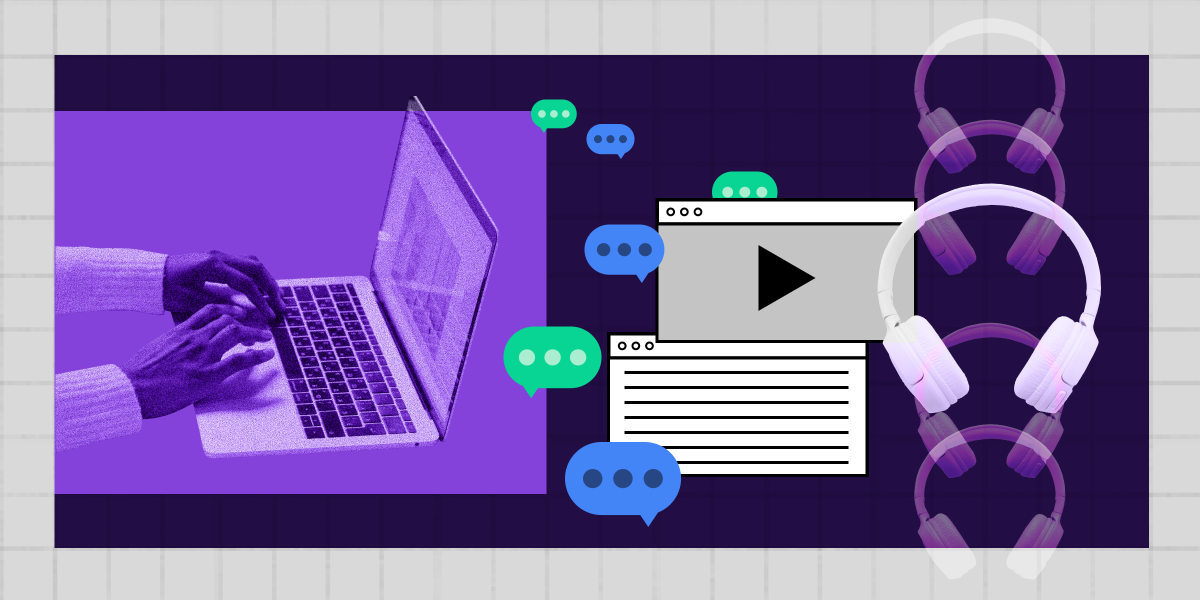Universal Design for Learning (UDL) is a framework that involves using a variety of teaching methods to respond to the needs of all your higher ed students. It is a teaching technique that provides flexibility in how instructional materials are delivered—and is ideal for supporting students of all backgrounds, cultures and abilities.
Table of contents
1. What is Universal Design for Learning?
2. What are the three core tenets of Universal Design for Learning?
3. Why should you use universal design in your online course?
4. How can you apply universal design in your online course?
5. Universal Design for Learning examples
6. Questions to ask yourself when designing an accessible course
7. The history of Universal Design for Learning
8. Bring UDL to life with Top Hat
9. References
1. What is Universal Design for Learning?
Universal Design for Learning (UDL) helps college and university educators create flexible programs that are easy to adapt to the unique needs of all students. This teaching framework involves using many techniques—in everything from course delivery to media use—to reduce barriers and reach every college student.1
UDL guidelines are put into practice in a variety of facets, including outside of academia. For instance, you may use closed captioning when watching television. Your smartphone can read the information on a website aloud. Meanwhile, automatic doors make grocery stores more accessible. In these three scenarios, UDL helps level the playing field for everyone, regardless of ability.
The UDL guidelines are presented as a graphic organizer, or a matrix table. Vertically, the principles are grouped under engagement, representation, and action and expression. Horizontally, the UDL principles are presented as access, build and internalize. Each guideline has corresponding checkpoints that include best practices. The graphic organizer helps viewers understand how criteria differ across the three principles. View the table below for a breakdown of the UDL guidelines.
| Provide multiple means of engagement |
Provide multiple means of representation |
Provide multiple means of action and expression |
| Recruiting interest |
Perception |
Physical action |
| Sustaining effort and persistence |
Language and symbols |
Expression and communication |
| Self-regulation |
Comprehension |
Executive function |
2. What are the three core tenets of Universal Design for Learning?2
- Action and expression: This learning approach involves giving students multiple ways to access information. Universal Design for Learning examples include giving students multiple ways to demonstrate that they’ve learned the material.
- Representation: A key tenet of this approach is providing information in multiple formats. Universal Design for Learning examples include offering students videos, books or interactive demos that cover the material covered in a lecture. Students can then choose the format that best suits their needs.
- Engagement: This approach is designed to motivate college students in a variety of ways. Universal Design for Learning examples include assigning projects that relate to a student’s background and interests. This pillar may be put into practice through gamification or discussions.
2.1. Multiple means of action and expression
This topic covers the ‘how’ of learning. It is also referred to as the strategic network. Each learner navigates the classroom in a different way, and they also express themselves uniquely. If someone has an executive function disorder, meaning they have trouble planning, organizing and problem solving, they will express themselves differently than someone who has a language barrier. For example, some postsecondary students are able to use written communication with ease, while others can only communicate through speech.
2.1.1. Executive functions
Executive functions encapsulate a human being’s highest level of skills. This ability allows learners to overcome their impulses to make long-term goals and strategies. Executive functions are limited by the individual’s working memory when executive functioning capacity is devoted to managing “lower level” skills that don’t come as naturally to a person. The individual’s capacity for executive functions can also be lowered by disabilities.
With universal design for learning, instructors can expand a learner’s executive function by scaffolding—that is breaking up lessons into bite-sized pieces—to ensure they do not use up the learner’s working memory. Educators can help students scaffold executive skills so that they can use them more effectively. Setting goals and creating plans to reach these goals can help. Professors can also support students by helping them self-monitor their progress over time, which helps students guide their practice through the semester. It also helps learners better understand what advice to ask their instructors for.3
2.1.2. Expression and communication
Every learner has a different capacity for expression and communication. In addition, various types of media may support different learning styles. For example, a learner who has dyslexia may perform better at expressing their thoughts through verbal conversations versus written essays.
Educators must provide different modalities for communication. This may involve using various types of media or tools for communication. Professors can help students become more fluent in a variety of communication modalities, which will then lend to independent learning.4
2.1.3. Physical action
Interactive software, textbooks and other curricular materials are recognized as Universal Design for Learning examples that can help students understand information. For instance, a postsecondary student may need a different type of workbook if they require assistive technology. These assistive technologies can help students who have disabilities. Some students could benefit from having expanded keyboards or voice-activated switches, for example.5
With this tenet of UDL, it’s important to vary the methods for response and navigation. This involves creating an accessible learning environment that all students can thrive in. The second part of this UDL principle involves opening doors to the tools that will create equal opportunity.
2.2. Multiple means of representation
This topic can be considered the ‘what’ of learning. It’s also referred to as the recognition network. Every learner absorbs the information that is presented to them in a different way. While a sensory or learning disability may cause this difference, cultural differences and different personalities may also affect how the student learns.
2.2.1. Comprehension
The goal of education is to help learners turn information into knowledge that they can apply in their everyday lives. With Universal Design for Learning, educators should get higher ed students involved in transforming and gathering usable knowledge. Gaining usable knowledge is an active process, so students need to be involved in order for this process to work. This means students need to use skills like consumption, categorization and active memorization. They must also learn how to integrate new knowledge with their prior understanding of the subject. The best Universal Design for Learning example here involves relying on organizers such as concept maps to help students visually draw connections between learning units. Metaphors, stories and analogies are also effective in helping students see the importance and relevance of topics.
To achieve these goals, instructors must present information in an accessible way. They should connect the information to previous experiences and offer background information as well. They can highlight relationships, patterns and information so that students can see how the information relates to their goals and other knowledge. Through breaking up lessons into digestible amounts, professors can support students as learners find meaning in their new knowledge and process the information. Finally, educators can help students apply information to new contexts.6
2.2.2. Language, mathematical expressions and symbols
Students interpret linguistic and non-linguistic symbols in different ways. While symbols like division signs provide clarity for some students, others do not understand specific symbols. Likewise, college students attribute different meanings to pictures or words based on their familial backgrounds and culture.
Because of this, educators must provide alternative representations for students. They should clarify different symbols, vocabulary, mathematical notations and syntax. If there is a pattern in different equations, grammar or musical notations, they should be explicit about it. When necessary, instructors should use translations, graphics, movement, activities, simulations, images and videos to make learning active.7 Try pairing a chemistry formula with an illustration or simulation to put this principle into practice.
2.2.3. Perception
Provide the same information through formats that stimulate different senses—ranging from sight, hearing or touch—to make lessons perceptible to learners. This practice will help students absorb information through audio, tactile or visual means. Instructors should also give students formats that can be adjusted such as text that can be increased in size. Other examples of perception include offering alternatives for video and auditory information.8 Such examples are providing videos featuring American Sign Language (ASL) and complementing audio clips with transcripts.
2.3. Multiple means of engagement
Providing multiple means of engagement can be thought of as the ‘why’ of learning. It’s also referred to as the affective network. Every college student is motivated in a different way academically. Likewise, students have different learning styles. While some love spontaneity, others will only feel comfortable when there is a daily routine followed in the classroom. Additionally, some prefer to work alone or in groups.
2.3.1. Self-regulation
Ideally, the learning environment should support and encourage the student’s motivation. When students are in higher education, they should be encouraged to learn how to regulate their own emotions and become self-motivated. By regulating their emotions, students can better cope with changes in their environment. A Universal Design for Learning example includes asking students how they’re feeling today on a scale of 1-5 to understand their needs and any accommodations.
Postsecondary students frequently learn how to self-regulate by observing their professors. Virtual classrooms can encourage this skill by modeling motivation and self-regulation. Then, educators can prompt students to use these abilities in real life. Instructors should discuss their expectations and help students set personal goals. They can support students as they self-assess their abilities and become more aware of their mistakes. Over time, students can learn how to develop healthy emotional responses to a variety of events.9
2.3.2. Sustaining effort and persistence
In order for a student to learn, they must make an effort to pay attention in class. If a student is motivated correctly, they can focus and make a sustained effort in the classroom. Each learner self-regulates in a different way, and these disparities are often due to their motivation levels. Other factors like contextual interference—a disruption in the motor learning phenomenon that affects how people learn and practice new skills—and self-regulation skills can also impact the student’s concentration. This is caused in part by the learner not seeing the value of certain goals and objectives.
Educators can support students by providing different resources to help them learn. Students are more likely to rise to the expectations set to them, so teachers should provide the tools that students need to succeed and help them achieve a certain level of understanding. When introducing goals, instructors should also discuss why each goal matters—put into practice through detailed criteria—so that students feel motivated to achieve each objective.10
2.3.3. Recruiting interest
If the information does not engage the student’s interest, it is essentially inaccessible. Students must be able to absorb and process information in their minds. Each student is interested in different topics of discussion, so teachers must figure out how to gauge their interest in different ways.
Instructors can attract the student’s interest by providing multiple choices whenever it is possible to do so. By allowing for individual choices and autonomy, educators can empower students to take control of their learning. Teachers should also connect the subject matter to experiences outside of the classroom. If university students believe the subject matter has value, they are more likely to be interested in learning it. Finally, teachers should attempt to eliminate distractions so that students have a safe space to learn new information.11
3. Why should you use universal design in your online course?
When using the UDL framework in an online course, you create equal opportunity for students of different backgrounds and abilities to learn the course material. If you are only teaching students in one specific way, many of your students may not be learning the information properly. Universal Design for Learning can help you make your course accessible to all types of learners.
When using the UDL framework in an online course, you create equal opportunity for students of different backgrounds and abilities to learn the course material.
4. How can you apply universal design in your online course?
When using the principles of UDL in your online course, consider the course’s engagement, representation, action and expression goals. Here are four ways to put Universal Design for Learning examples to use in your class.
4.1. Syllabus
Your course syllabus shows college students what they will be learning in the upcoming quarter. It should give students multiple ways to engage with the content, such as through class readings, podcasts, webinars and guest lectures. The syllabus can communicate regular routines, assessment formats and expectations. It should also include the ways that students can access the course content. Consider adding headers and subheadings in your syllabus to make it accessible for screen readers. Download Top Hat’s syllabus template now, available in either Google Docs or Word format.
4.2. Course materials
To follow the principles of universal design, you should select an array of course materials. Instead of only using a textbook, your course can incorporate podcasts, discussion boards, essays, videos and physical activities. By changing the way students can absorb information, you can make the course information accessible to every student.
4.3. Assessment
While some students can take a written test without any issues, others have trouble reading written tests or turning them in. In the realm of assessment, Universal Design for Learning examples might include using video conferencing software to measure student understanding. Depending on the coursework, you could also use assessment techniques like recorded videos.
4.4. Teaching
In order to make your course more accessible, vary the way you teach your course. Images, graphs and textbooks are effective in helping students understand information. Some students learn better through audio tracks, so you may want to use a recorded lecture, video or podcast as well. In addition, you can teach students through discussion groups and other techniques as well.
Top Hat’s Student Engagement toolkit is packed with templates and strategies to create accessible assessments, lesson plans and classroom discussions. Access now.
5. Universal Design for Learning examples
The following list includes Universal Design for Learning examples that you can use to create an equitable and accessible learning environment. You can also create other feedback, assignment and learning options that help diverse learners master the course material in your class.
5.1. Assignment options
Students can achieve the course’s learning objectives through a variety of assignment styles. Beyond traditional homework, students can also submit video recordings of a presentation or speech. They can alternatively create comic strips or podcasts. Another Universal Design for Learning example involves flexible assignment due dates. This policy accommodates students who may have obligations outside of class, such as work or family responsibilities, or who may need additional time due to disabilities or health issues.
5.2. Regular feedback
In order for students to improve, they must regularly receive detailed feedback. Formative assessments can help with this goal, where the student’s ongoing learning is monitored. These assessments also provide feedback that educators can use to improve their course delivery.
5.3. Digital and audio text
Textbooks are just one way that university students can learn. Audiobooks and text-to-speech programs can also help. In addition, you can use audio transcripts and videos with closed captions for students who require assistive technologies. Professors can use multiple modes of communication to convey information, including verbal instructions, written handouts, visual aids, and online resources. These specific Universal Design for Learning examples help students with diverse language abilities, learning styles, and sensory preferences to comprehend the material effectively.
6. Questions to ask when designing an accessible course
6.1. Multiple means of engagement
- Does the course encourage independent student responsibilities? In order for college students to learn, they have to be motivated and engaged. When students work independently on coursework, they feel responsible for the outcome. They also become more engaged in studying the material. Consider facilitating surveys or a student interest inventory at the start of the semester to gauge interests, hobbies and strengths. You can then use this information to tailor units of study accordingly.
- Can students complete at least some course content at their own pace and in any order they wish? Everyone learns at a different pace. When the course moves too quickly, students can fall behind. Over time, this can cause students to lose motivation. Letting students learn at their own pace in a blended or online course acknowledges their unique circumstances and provides them with the time they need to engage with the course material. Consider implementing an assignment ‘grace period’ to allow students to plan their schedules accordingly based on priorities.
- Are course learning goals and outcomes clear? When students are confused or lost, it is impossible for them to become engaged in the course material. You can remove this obstacle by clarifying your learning goals. When students know what to expect and what they need to do, they are more likely to achieve the course’s goals.
6.2. Multiple means of representation
- Is the course content provided in multiple ways? With Universal Design for Learning, the goal is to help postsecondary students from all backgrounds and abilities. Students may have visual or aural impairments or have a disability. They may also come from a culture where subject matter is taught differently. Ideally, your course content should be provided through multiple techniques so that everyone has an equal opportunity to learn. Universal Design for Learning examples include complementing course readings with interviews or videos.
- Do learning opportunities and assignments use students’ prior knowledge? You can help students retain information by connecting it to their prior knowledge. You can show how new information relates to a previous class or personal experience. Sometimes, you can even assign students the task of reflecting on everything they have learned and how the new topics related to their personal experiences.
- Does the course have interactive learning activities online? If you are teaching online, ensure you have multiple ways to get students involved. Interactive activities help students feel like active participants in the learning process. Because students are more likely to learn when they are actively involved, this technique is extremely important for online learners. It ensures that students are just as motivated in their studies, even from a distance. Complement lectures or readings with simulations or other opportunities for students to apply their knowledge.
6.3. Multiple means of action and expression
- Have you provided students with note taking support? There are many different disabilities that can make it difficult for students to take notes. To help your students, offer them multiple ways to take notes in class. They can use videos, audio recordings or written techniques to recall information. Some students may also benefit from making graphs or drawings of the new course material.
- Does the course include a variety of assessment methods? While some students can take written tests, this is not the best way to assess every student. Universal Design for Learning examples that support a flexible assessment strategy include video interviews, recordings, posters and other techniques. If you use written tests, you may need to offer support such as audio recordings of the questions and answers. Balance summative assessments with low stake formative assessments that enable students to receive more regular and timely feedback.
- Are college students encouraged to communicate with faculty and classmates in the course? Open communication between faculty and students—and especially on the student-student level—helps many learn and absorb new information. Ideally, instructors should offer multiple ways for students to communicate with their classmates and teachers. Universal Design for Learning examples could include using online forums, video conferences, interviews or essay feedback to host conversations with students.
Our Teaching with Top Hat Toolkit offers videos and helpful resources to design an accessible learning community in our platform. Browse the toolkit today.
7. The history of Universal Design for Learning
Originally, this technique started out as an architectural concept. In architecture, universal design refers to creating designs that appeal to everyone. These designs must also comply with the Americans with Disabilities Act (ADA). Because of the ADA, many schools began using inclusive facilities and providing equal access to their courses. Originally, the idea of universal design in architecture was created by architect Ron Mace at North Carolina State University.
In 1984, the Center for Applied Special Technology (CAST) was formed. CAST applied the original universal design guidelines to the educational space as a means of facilitating reform. Today, the CAST website houses plenty of instructional design tips and professional development strategies to make the postsecondary education experience more accessible.12
8. Bring UDL to life with Top Hat
Top Hat’s feature suite ensures your students have access to an equitable learning environment. Postsecondary students are able to learn from anywhere—the platform’s offline mode still lets students complete their homework assignments, even without having an Internet connection. Similarly, students can use multiple devices to engage with content stored in Top Hat. Top Hat is compatible with assistive technologies such as screen readers, plus keyboard navigation makes it simple to navigate through content.
Outside of class time, alternative text on images in textbook readings helps students using screen readers understand the visuals alongside the text. Instructors can personalize the learning experience for individual students by customizing assignment due dates and grade weights. This ensures students have multiple ways to express their knowledge—and at a time that suits them.
Top Hat’s accessibility features create a level playing field in your course. Learn more about what Top Hat can do for your students here.
9. References
- Morin, A. (n.d.). What is Universal Design for Learning (UDL)? Understood. https://www.understood.org/en/learning-thinking-differences/treatments-approaches/educational-strategies/universal-design-for-learning-what-it-is-and-how-it-works
- CAST. (n.d.). The UDL Guidelines. http://udlguidelines.cast.org/
- CAST. (n.d.). Executive Functions. http://udlguidelines.cast.org/action-expression/executive-functions/executive-functions
- CAST. (n.d.). Expression & Communication. http://udlguidelines.cast.org/action-expression/expression-communication
- CAST. (n.d.). Physical Action. http://udlguidelines.cast.org/action-expression/physical-action
- CAST. (n.d.). Comprehension. http://udlguidelines.cast.org/representation/comprehension
- CAST. (n.d.). Language & Symbols. http://udlguidelines.cast.org/representation/language-symbols
- CAST. (n.d.). Perception. http://udlguidelines.cast.org/representation/perception
- CAST. (n.d.). Self regulation. http://udlguidelines.cast.org/engagement/self-regulation
- CAST. (n.d.). Sustaining Effort & Persistence. http://udlguidelines.cast.org/engagement/effort-persistence
- CAST. (n.d.). Recruiting Interest. http://udlguidelines.cast.org/engagement/recruiting-interest
- OCALI. (n.d.). History of UDL. https://www.ocali.org/project/learn_about_udl/page/udl_history





